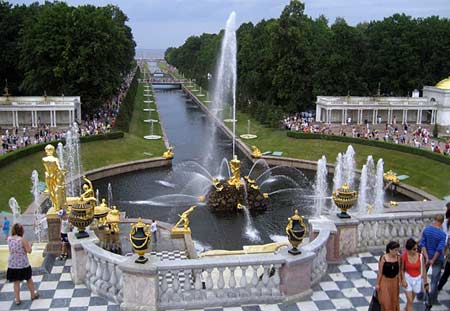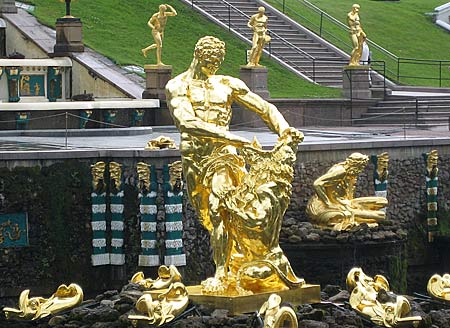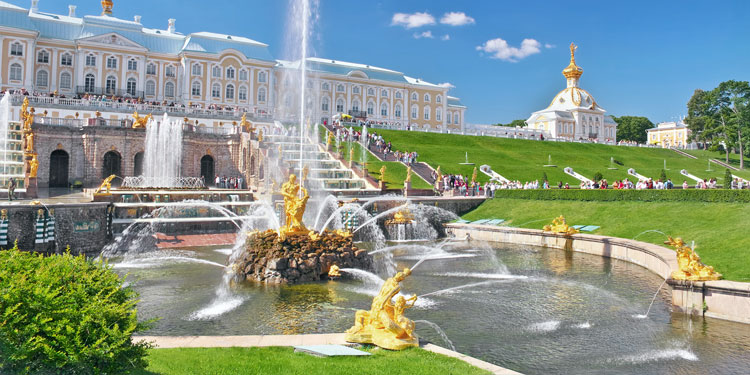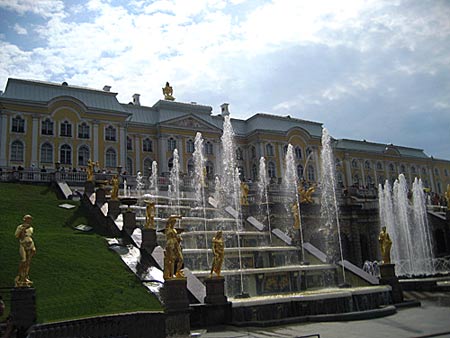
Peterhof is a small town, suburb of St. Petersburg. It is located on the shores of the Gulf of Finland, at a distance about 30 kilometers south-west of the center of St. Petersburg. The population of the town is about 78,500 people.
Peterhof got its name from the German word Peterhof — «Peter’s Court». From 1944 to 1997 the town was called «Petrodvorets».
Peterhof was founded in 1710 as the emperor’s country residence. It received the city status in 1762. There were villages Kuusoja and Pohjajoki on the place of Peterhof on the coast of the Gulf of Finland prior to the beginning of the XVIII century. The most famous town landmark is the «Peterhof» museum.
Sea Channel view of the in Peterhof from the Grand Palace is shown in the picture.
The Museum Peterhof includes: «Peterhof Grand Palace,» «Upper Garden», «Lower Park» and other objects.
The most interesting place for tourists (in summer) in Peterhof is «Lower Park». Lower Park has an area about 102 hectares. The park stretches from west to east along the coast of the Gulf of Finland by 2.5 kilometers. Its width from north to south is about 500 meters.
The main decorations of the park are its fountains. «Grand Cascade» fountain is situated in the central part of the park, in front of Grand Palace. «Sea Canal» is laid from the Grand Cascade to the coast. The canal divides the park into two parts. «Adam» and «Eve» fountains, «Chess Mountain» and «Gold Mountain» fountains cascades, Monplaisir Palace and Hermitage Pavilion are located at the equal distance from the canal on both sides of the park. «Oak» and «Umbrella» fountains are children’s favorites. The most famous fountain in the park is «Samson tearing the lion’s mouth» named fountain.
The sculpture «Samson tearing the lion’s mouth» is shown in the photo (water off).
Operating mode of the Peterhof Lower Park
- The park is open (summer 2016): 09:00 — 20:00.
- On Saturdays, the park is open from 9:00 to 21:00.
- Ticket office opening hours: 09:00 — 19:30.
- Fountains operate weekdays from 10:00 to 18:00 on weekends and public holidays from 10:00 to 19:00.
- Launch of the Grand Cascade fountains: 11:00.
- Entrance fee to the Lower Park: 450 rubles (for citizens of Russia and Belarus). There are exemptions for certain categories of citizens. Prices for the summer season 2016. The cost of the full ticket for foreigners is 700 rubles.
How to get to Peterhof
The most convenient way to get to Peterhof is by boat or by bus.
By bus (bus stop «Fountains», «Фонтаны» Петергоф).
From metro station «Avtovo» departs buses № 200, 224, № 300, № 424, № 424-A.
From metro station «Leninsky Prospekt» departs buses number 103, K-224, № 420.
From metro station «Prospect Veteranov» departs buses № 343, № 639-b.
By train from the «Baltic Railway Station», then by bus: № 344, 348, 350, 351, 352,355, 356.
Sea transport departs from the pier on Palace Embankment 18 (near the Winter Palace in St. Petersburg).
By car — check place location on the map. There is a paid parking, but free parking is also available.
- Home
- Russia
- Peterhof
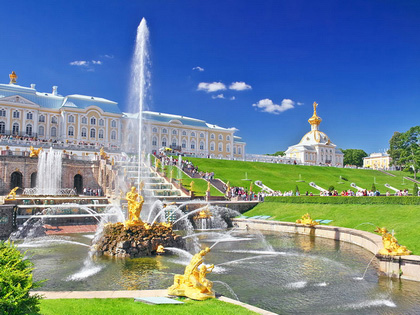
Highlights of St. Petersburg Tour
Explore Russia’s elegant northern capital on this 4-day highlights of St. Petersburg tour. Discover the city’s architecture and history as you visit palaces, canals, and churches, and take an excursion to the magnificent Peterhof Palace and fascinating Kronstadt.
St. Petersburg, Peterhof, Kronstadt
4 Days | All year round | from US$ 427 / personDetails
Peterhof: St Petersburg’s Magical Summer Palace
Peterhof is the most magical palace in Russia. Set in a lush estate on the southern coast of the Finnish Gulf, it was the Royal family’s favourite summer retreat. Generations of Tsars poured fortunes into fashioning Peterhof into a fantasy-land. The original Grand Palace which Peter the Great built was constantly being expanded, till it reached over 300 meters long and included two towering cathedrals on either end of its façade. Considering that the length of Versailles stretches to 400m, one might think that Peter the Great failed to achieve his dream of creating an estate grander than King Louis’s. But it is the gardens and fountains of Peterhof and not its palace that has earned it the title of the world’s most splendid Royal Residence.
Did you know? The Grand Cascade fountain in Peterhof is one of the largest monuments from the XVIII century.
Why Visit Peterhof?
- Fountains: There is no place on earth with fountains as numerous or magnificent as Peterhof. Though the fountains don’t flow with milk and honey, on a hot summer day the spectacular fountains can make the estate seem like paradise.
- Nature: The gardens in Peterhof stretch for miles and include the best landscape design from around the world. Along with the acres of landscaped English parkland, there are stunning French formal gardens surrounding the Grand Palace and pretty Italian terraces tumbling down to the sea.
- Palaces: Peterhof is an estate of not one but many palaces. The variety of architecture reflects the changing tastes over the years. Peter the Great’s humble Mon Plasir looks like a cottage in comparison to the Grand Palace of Elizabeth the Great!
The Fountains of Peterhof
Cascading from the foot of the Grand Palace all the way to the waters of the Baltic sea, the Grand Cascade is one of the 18th century’s most impressive scientific and architectural wonders. Sixty miniature fountains and over 250 golden statues make up the two perfectly symmetrical, tiered fountains which join to form one large marine canal. The gushing of grand waterfalls, splashing of roman fountains, trickle of streams and rippling of ponds filled with swans, saturate the air of this seaside palace with a magical mist that is beyond compare. Though the Grand Cascade is the crowning glory of Peterhof, it is by no means the only fountain. Throughout the grounds, there are 176 fountains in total — far more, Peter the Great would boast, than the 55 in Versailles. Read more about Peterhof’s fountains.
Did you know? All Peterhof’s fountains were designed to run without any pumps. The giant ponds in the Upper Gardens, which were once fish ponds, are high enough to build adequate water pressure to feed even the 21m high, Samson and the Lion spouting fountain!
The Secrets of Peterhof
For all his achievements, the mastermind behind Peterhof was a rascal. Peter the Great delighted in breaking conventions and shocking the Russian nobility. The Summer Palace and Gardens, therefore, were filled with practical jokes ready to be unleashed on tight-lipped aristocrats. By definition, boobytraps are hard to find. Even though visitors to Peterhof now have maps, many aren’t even aware of the secrets within Peterhof — that is unless they are unlucky enough to set a boobytrap off! Here are just a few of the surprises hidden within the grounds:
The Water-Road
Designed in the 1720s by Peter himself, this was the largest of his boobytraps. Perforated pipes were laid down the entire length of one of Peterhof’s tranquil alleyways. At the flick of a hidden switch, Peter could soak up to one hundred people under a downpour! Later tsars, however, seemed to be either far less fun-loving or just not brave enough to soak hundreds of aristocrats at a time because they closed off the pipes as soon as Peter died. Thankfully, the Soviets saw the fun that could be had in wetting tourists and they reopened the Water-Road.
The Grotto
Few tourists ever find out about the Grotto. It’s hidden right under the main attraction — the Grand Cascade — and, apart from being one of the few parts of Peterhof that survived the Nazi occupation intact, it also has a few of Peter’s most ingenious tricks tucked within its cavernous walls. Take the forbidden fruits, though not literally; for if you do succumb to the temptation of reaching out for a plump nectarine from the fruit bowl on the Grotto’s central table, then you shall be punished with an almighty spurt of water! Should you be spooked by the deities with their gaping mouths or the dark corridors, don’t make the mistake of running out in haste. One wrong step and you risk setting off the Curtain of Water!
The Benches
In the quiet of the woodlands lining the Finnish gulf, Peter built himself a homely cottage called Mon Plasir. It’s a charming place, still furnished with Peter’s personal belongings and with a picture-perfect view onto the bay. After walking through hectares of the estate, many a tourist has taken refuge in its walled gardens and rejoiced at seeing a pretty white bench in the shade. Indeed, if you were there in Peter the Great’s day he may well have invited you to join him while sitting on one such bench. Never trust a Romanov! The cobbled stones in front of the benches are a veritable minefield; with every second one positioned above a valve that unleashes torrents of water.
The Green Umbrella
Most umbrellas protect from rain but, in the wonderland that is Peterhof, even the most ordinary things become extraordinary. Built in 1794, a time when Oriental gardens were all the rage, this giant, green umbrella with a bench encircling its base took its stylistic inspiration from Tsarskoye Selo’s Chineese Buildings. Therein ended its connection with China. Serene tea gardens were much too dull for the Tsar so, instead, he rigged the gazebo with a sprinkler system that would trap anyone who sat under it in a circle of water.
Lead Trees and Tulips
When the Nazis seized Peterhof they cut down the estate’s ten thousand trees. The greatest loss though wasn’t the ancient oaks or perfectly clipped lime trees, but rather the 6m high fir trees made entirely of lead tubes. From a distance, their 2,500 painstakingly painted leaves seemed to flutter in the breeze like the surrounding trees but, on closer inspection, visitor’s were shocked to see that the trees and tulips at their base were artificial. Fascinated aristocrats would try to take a closer look at these imitations of nature only to be greeted with hundreds of water spurts from the cracks in trunks of the trees.
Did you know? The Grotto is also home to Peterhof’s original wooden pipework that fed the Grand Cascade and a mini-exhibition on the history of hydraulics.
Visit Peterhof Today
After the barbaric sacking of Peterhof by the Nazis, the communists surprised everyone by full- heartedly committing to restore Peterhof, down to the very last gilded candelabra. Since the 1990s, Peterhof has been a UNESCO-heritage site and it has since been declared one of Russia’s seven wonders.
Peterhof was built to be experienced in summer. Though its palace looks exceptionally large from the outside, inside there are only 30 rooms worth seeing. And, while the hall with 368 paintings is quite a sight, it is the fountains that make Peterhof what it is. To see Peterhof’s fountains, you must come between late April and September. The height of summer is, of course, the best time to visit a summer palace, but May and September are also popular months to visit.
On May 16th the official opening of the fountains is celebrated much as it would have been in Peter’s time with orchestras and dances. The grand closing ceremony in late September, however, is much more modern with light-shows, fireworks and loud music. For St Petersburg, these events are the highlight of the year so it’s best to book tickets well in advance.
If visiting on a normal day, make sure to arrive early and book tickets online to avoid standing in queues for upwards of 20 minutes. After exploring the Upper Gardens, which are rather small and only contain a few fountains, enter the Lower Gardens and follow the crowds to the Grand Cascade which comes to life at 11 each morning. Later, make your way to Peter’s great boobytrap, the Water-Road, which thrills hot and weary travellers with bursts of water at 1 pm, 2 pm and 3 pm sharp.
While marvelling at all the fountains and gawping at the magnificent vistas, keep an eye out for the estate’s cute residents. These tiny red squirrels and chirping blue-tits are so tame that all a passerby needs to do is place a few seeds on an open palm for a whole menagerie of sweet animals to come running and flying to them. Seeds and nuts are sold throughout the park, but the price is as royal as the surroundings so it’s best to buy a pack of sunflower seeds in a shop before the trip.
Did you know? Straight after the Bolshevik revolution, Peterhof was turned into communal flats! Thankfully, the soviets soon saw the blunder they made and soon turned it into a museum.
Attractions
- Текст
- Веб-страница
петродворецПетерго́ф (нидерл. Peter
петродворецПетерго́ф (нидерл. Peterhof, «двор Петра») — дворцово-парковый ансамбль на южном берегу Финского залива в 29 км от Санкт-Петербурга. Находится на территории города Петергоф (с 1944 года по 1997 год [1] — Петродворец). От него происходит название Петергофской дороги. Часть его находится в ведении Государственного музея-заповедника «Петергоф».
Петергоф включает в себя несколько дворцово-парковых ансамблей, формировавшихся на протяжении двух веков. Нижний парк, Верхний сад и Английский парк — ансамбли, получившие развитие в XVIII веке; Александрия, Колонистский парк, Луговой парк, Александровский парк, Сергиевка, Собственная дача Александра II — ансамбли XIX века.
0/5000
Результаты (английский) 1: [копия]
Скопировано!
petrodvorecPetergóf (refer to. Peterhof, Peter «yard») is a Palace and park ensemble on the southern shore of the Gulf of Finland at 29 km from St. Petersburg. Located in the city of Peterhof (1944 year by year 1997 [1], Peterhof). It takes its name from the Peterhof road. Part of it is managed by the State Museum-preserve «Peterhof».Peterhof includes several Palace-park ensemble, had for two centuries. The lower Park, the upper garden and English park-ensembles, translated in the 18th century; Alexandria, Kolonistskij Park, Meadow Park, alexandrovsky Park, Sergievka, a private dacha of Alexander II — ensembles of the 19th century.
переводится, пожалуйста, подождите..
Результаты (английский) 2:[копия]
Скопировано!
petrodvoretsPetergof (niderl Peterhof, «Peter the yard.») — the palace and park ensemble on the southern shore of the Gulf of Finland, 29 km from St. Petersburg. Located in the town of Peterhof (from 1944 to 1997 [1] — Peterhof). From him comes the name of the Peterhof road. Part of it is the responsibility of the State «Peterhof» Museum.
Peterhof includes several palaces and park ensembles, evolved over two centuries. Lower Park, the Upper Garden and the English Garden — ensembles that were developed in the XVIII century; Alexandria Kolonistsky Park Meadow Park, Alexander Park, Sergievka, En cottage Alexander II — ensembles of the XIX century.
переводится, пожалуйста, подождите..
Результаты (английский) 3:[копия]
Скопировано!
петродворецпетерго́ф (нидерл. Peterhof «backyard петра») — дворцово park ensemble on the southern shore of the gulf of finland 29 km away from st. petersburg. is located in the territory of the city of peterhof (from 1944 to 1997 [1] — петродворец). it is the name of петергофской road. part of it is managed by the national museum of the петергоф».peterhof includes several дворцово layouts showing формировавшихся for two centuries. the park, the english garden and park ensembles, as developed in the 18th century, alexandria, колонистский park, meadow park, alexander park, сергиевка, own a alexander ii — from the 19th century.
переводится, пожалуйста, подождите..
Другие языки
- English
- Français
- Deutsch
- 中文(简体)
- 中文(繁体)
- 日本語
- 한국어
- Español
- Português
- Русский
- Italiano
- Nederlands
- Ελληνικά
- العربية
- Polski
- Català
- ภาษาไทย
- Svenska
- Dansk
- Suomi
- Indonesia
- Tiếng Việt
- Melayu
- Norsk
- Čeština
- فارسی
Поддержка инструмент перевода: Клингонский (pIqaD), Определить язык, азербайджанский, албанский, амхарский, английский, арабский, армянский, африкаанс, баскский, белорусский, бенгальский, бирманский, болгарский, боснийский, валлийский, венгерский, вьетнамский, гавайский, галисийский, греческий, грузинский, гуджарати, датский, зулу, иврит, игбо, идиш, индонезийский, ирландский, исландский, испанский, итальянский, йоруба, казахский, каннада, каталанский, киргизский, китайский, китайский традиционный, корейский, корсиканский, креольский (Гаити), курманджи, кхмерский, кхоса, лаосский, латинский, латышский, литовский, люксембургский, македонский, малагасийский, малайский, малаялам, мальтийский, маори, маратхи, монгольский, немецкий, непальский, нидерландский, норвежский, ория, панджаби, персидский, польский, португальский, пушту, руанда, румынский, русский, самоанский, себуанский, сербский, сесото, сингальский, синдхи, словацкий, словенский, сомалийский, суахили, суданский, таджикский, тайский, тамильский, татарский, телугу, турецкий, туркменский, узбекский, уйгурский, украинский, урду, филиппинский, финский, французский, фризский, хауса, хинди, хмонг, хорватский, чева, чешский, шведский, шона, шотландский (гэльский), эсперанто, эстонский, яванский, японский, Язык перевода.
- What is her name?
- nice to live not forbid
- l’amore per i genitori vive in eterno
- В викторианской семье няня занималась с
- Аскаридоз свиней
- There’s no any agreement between Austral
- SHARE OFFERBY KITCHEN MANUFACTURERNext m
- В викторианской семье няня занималась с
- SHARE OFFERBY KITCHEN MANUFACTURERNext m
- The symbolic relationship between the au
- Я не могу сказать точно
- if medicine is taken incorrectly, it may
- brother runing
- if medicine is taken incorrectly, it may
- Processing: Arrived at the place of deli
- Ты меня бесишь
- brother runing
- Tamam iş yoğun
- Immer, wenn Falk und Alexandra eine Klas
- не отвечаю мне
- The symbolic relationship between the au
- Лазить с кем либо
- Чувство юмора
- Иногда по-разному
Слайд 1
Санкт-Петербург ГОУСОШ №127 Красногвардейского р-на Филиппова Татьяна Александровна у читель английского языка
Слайд 2
PETERHOF — THE CAPITAL OF FOUNTAINS
Слайд 3
Peterhof is located 30km west of St. Petersburg on the shores of the Gulf of Finland. It was the summer residence of Peter the Great, built to commemorate victory over the Swedes in 1709 and to show the strength of the Russian Empire . The official opening of Peterhof was on the 15 of August in 1723.
Слайд 4
Peterhof was designed to resemble Versailles in France and architects from all over the world were involved in its design. Over 4000 peasants dug the gardens, parks and canals, and Peter I himself helped to plan the layout of the gardens and fountains. Versailles in France
Слайд 5
Vasily Tuvolkov , Russia’s first hydraulics engineer, built the fountains in 1721-1722.
Слайд 6
The Great Cascade fountain in the gardens has 17 waterfalls, 142 water jets, 66 fountains, 29 bas-reliefs and 39 gilded statues, including the famous five-ton Sampson Fountain. The Grand Cascade divides the Lower Park into east and west.
Слайд 7
Another fountain , the Chessboard Hill, contains some of the best waterfalls cascading over bronze dragons.
Слайд 8
The Triton Fountain shows Neptune’s son wrestling with a sea monster.
Слайд 9
The Pyramid fountain was designed by Peter I and is made up of seven tiers and 505 jets .
Слайд 10
Some of the fountains are there to surprise and amuse visitors. The Little Umbrella fountain sprays out water from 164 jets as soon as anyone sits on a bench underneath it.
Слайд 11
The Little Oak fountain sprays out water if it senses any weight approaching it.
Слайд 12
The Pebbles fountain also drenches visitors who sit on a nearby bench.
Слайд 13
To feel happy and make their spirits high, Russians and foreign visitors come to Peterhof to enjoy its magic charms .
Слайд 14
WELCOME!!!
Слайд 15
Resources: Evans V ., Afanasyeva O., Vaulina J.. Click on Russia Culture Clips 2 / Express Publishing – Centercom , 2003. – p.32 G. Kenyon. The Environs Of Saint Petersburg. Peterhof. Tsarskoye Selo . Pavlovsk. P-2 Art Publishers, St Petersburg, 2002. – p. 63 http :// www.rthvictoria.com/wp-content/ uploads/2015/03/Fontanyi-Petergofa.jpg https://s14.stc.all.kpcdn.net/share/i/4/697709 / wx1080.jpg http:// www.alekseitrofimov.eu/lj2015/201507-saint — petersburg / IMG_40991-SAINT-PETERSBURG-PETERHOF.JPG

